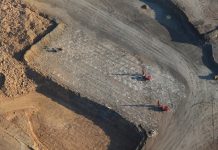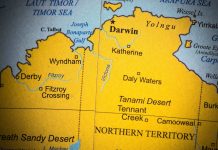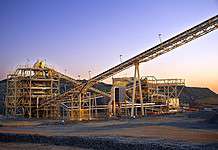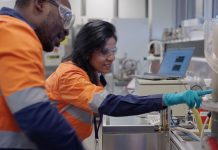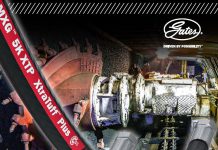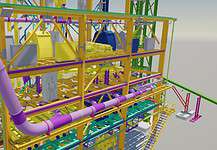THE $3.5b Koodaideri iron ore mine in WA is progressing to plan with engineering, procurement and construction activities on schedule for first production in late 2021.
Koodaideri will deliver a new production hub for Rio Tinto’s world-class iron ore business in the Pilbara, incorporating a processing plant and infrastructure including a 166km rail line connecting the mine to the existing network.
This includes construction of a new bridge in the Pilbara to carry the Great Northern Highway traffic over the proposed Rio Tinto Iron Ore Koodaideri Rail Line.
The bridge project, funded by Rio Tinto and managed by Main Roads, is expected to create a minimum of 40 local jobs with a $23m contract awarded to a joint venture between ACCIONA Geotech and Clough Projects (ACJV) for roadworks and bridgeworks.
WA Transport Minister Rita Saffioti said an average of 721 vehicles per day use this section of Great Northern Highway, around two-thirds of which are heavy vehicles.
“This project will significantly increase efficiency and improve safety for road users by eliminating the road/rail conflict,” she said.
“Rio Tinto has acknowledged the potential risk to the public with their rail operations and are to be commended on their proactive approach to engage Main Roads to construct a new bridge – the safest possible crossing infrastructure for the travelling public.”
The works include the construction and realignment of 3.6km of Great Northern Highway and a new intersection at the Rio Tinto mine access road to the Koodaideri project which is expected to be completed in June 2020.
Phase 1 of the mine construction is currently underway, and along with mine infrastructure, an airport, mine support facilities and accommodation for employees will be built with engineering firm Worley contracted for the the engineering, procurement and construction management for the project.
Throughout the construction period, Rio Tinto expects to employ more than 2000 people with 600 permanent roles created once the mine is operational.
The project will increase the higher-value lump component of the Pilbara Blend (subject to market conditions) from the current average of about 35pc to around 38pc.
It’s anticipated the ore will help sustain Rio Tinto’s existing production capacity by replacing depletion elsewhere in the system.
A $44m pre-feasibility study into Koodaideri Phase 2 is also underway – which could increase annual capacity to 70mt and help the company achieve its long-term goal of 360mt of iron ore shipped from Australia in 2022.
Autonomous operations
Koodaideri will feature technology already in use across Rio Tinto, such as autonomous trucks, trains and drills, and implement systems connecting all components of the mining value chain for the first time.
The development will consolidate everything Rio Tinto has learned from its studies into finding advanced ways to extract minerals while reducing environmental impacts and improving safety, known as the Mine of the FutureTM program.
Rio Tinto chief executive Jean-Sébastien Jacques said that the operation has been designed to utilise an increased level of automation and digitisation which Rio Tinto expected would significantly enhance productivity, safety and maintenance of the new mine.
“Koodaideri is a game-changer,” he said.
“It will be the most technologically advanced mine we have ever built and sets a new benchmark for the industry in terms of the adoption of automation and the use of data to enhance safety and productivity.”
Innovations for the project include a digital replica of the processing plant, accessible in real time by workers in the field, fully integrated mine automation and simulation systems, advanced automation including an automated workshop, and numerous data analytics capabilities and control loops to optimise production and reduce downtime.
Global equipment manufacturer Caterpillar will provide state-of-the-art heavy machinery for Koodaideri which will be integrated with Rio Tinto’s Mine Automation System (MAS) – which collects and enhances data created by the company’s mining operations, to improve productivity across Rio Tinto’s entire iron ore network.
As part of the Mine of the FutureTM program, the two companies will also be studying the potential for increased levels of automation of heavy mining equipment at the mine in the future.
Rio Tinto Iron Ore chief executive Chris Salisbury said the partnership would help make Koodaideri the most technology-enabled and innovative mine in the Pilbara iron ore network.
“Technology is rapidly changing our mining operations as we harness innovation to make our operations safer, smarter and more productive,” he said.
Rio is also investing in skills and training for the new roles the autonomous technology will require in the workplace.
“The development and adoption of technology will continue to change the way we work, and we remain committed to providing opportunities for new roles, new skills, redeployment and retraining,” Mr Salisbury said.
“Our partnership with the Western Australian government and South Metropolitan TAFE is working to develop the first nationally recognised certificates in automation, helping to ease the industry’s transition to the mines of the future.”
Mr Salisbury said the leading-edge technology will deliver a step-change in both safety and productivity for the company.
“Subject to final approvals, Koodaideri will incorporate all of that knowledge to enable us to build the smartest, safest and most efficient mine we’ve ever constructed,” he said.


